Electrical assemblies need strong adhesives that provide reliable adhesion and the attributes required for consistent electrical performance. Disconnected parts and electromagnetic interference can interfere with functionality, but specialized adhesives such as electrically conductive tape can ensure longer-lasting performance.
Manufacturers use electrically conductive tapes to assemble complex electronics, even replacing soldiering in some applications. The product has metal particles or a web of metal material within the tape’s polymer that conducts electricity. Often double-sided, this tape can hold electrical components in place without the risk of slippage or movement and help control the flow of electricity along the predetermined pathways. One of the most common uses for electrically conductive tape is the attachment of electromagnetic interference (EMI) and radio-frequency interference (RFI) shielding.
Tapes also replace composite adhesives in many applications. Available in solid or liquid forms, composite adhesives bond materials together after curing and drying. Some of the most common composite adhesives include epoxy adhesives, structural acrylics, polyurethane adhesives, cyanoacrylates, and UV curable adhesives.
With numerous electrically conductive tapes on the market, it can be challenging to choose the right solution for a specific application. Our experts have compiled the following resources to help you select a suitable conductive tape for your needs.
Types of Conductive Tapes
Electrically conductive tape comes in multiple types and strengths, but they fall under two broad categories: isotropic conductive tapes and anisotropic conductive tapes.
- Isotropic conductive tape can conduct electricity in any direction. Manufacturers prefer this type of tape for bonding chips and attaching surface-mount devices (SMDs).
- Anisotropic conductive tape contains microscopic conductive particles and conducts electricity unidirectionally. While this offers less flexibility, it is a better choice for LCDs, LEDs, RFIDs, and other sensitive components.
Applications That Use Electrically Conductive Tape
Electrically conductive tapes are versatile materials that manufacturers can use in virtually any complex electronic device assembly. Tapes are especially ideal for mobile devices and equipment, as they can reliably fix a variety of components with minimal risk of breakage or displacement. Here are some of the most common applications for electrically conductive tapes.
Electrical Interconnection and Assembly
Electrically conductive tapes see frequent use for completing interconnections and assembling components without adding unnecessary bulk—the adhesives bond to the surfaces through pressure-sensitive adhesion or heat-activated bonds. Depending on the configuration’s sensitivity and the complexity of the assembly machinery, either choice can create a permanent bond between different components in an assembly.
Pressure-sensitive adhesive tapes have become standard in many assemblies that are visible to consumers and users. For example, in smartphones, the adhesives can bond the touch screen to its protective housing with little loss of optical clarity around the contact points.
Static Dissipation and Control
Electrical and electronic assemblies can build up static energy over time. If left uncontrolled, this excess noise will disrupt the performance of the device. Antistatic electrical tapes shield cables and electrical components from this static interference. Some static control tapes also have a low-friction surface to disrupt the potential buildup of static.
These tapes can also shield components from electromagnetic interference and radio frequency interference. This capability can be especially crucial for electrical configurations that operate in close quarters with other assemblies, whether in the same device or just in the same area. Computers often house multiple assemblies that have the potential to interfere with each other. Potentially crowded spaces, such as server rooms, may also contain numerous devices and types of equipment that need shielding so they can run simultaneously.
Medical Electronics
Electronic medical equipment must operate reliably without the risk of an unexpected failure. As such, medical equipment requires a guarantee against interference and critical errors that may impede functionality. Because environments like hospital rooms contain multiple electronic medical equipment types, protection against EMI and RFI-based malfunctions is essential in any piece of equipment intended for use in medical settings. Antistatic tapes decrease the passage and buildup of interference. These tapes also securely attach shielding components in different configurations within the equipment to isolate components from external or cross-component interference
Medical Devices
Mobile medical tools and implantable medical devices need just as much of a guarantee against noise and interference as stationary medical equipment. However, they also need advanced protection against more mechanically induced malfunctions, such as jostling, walking, physical impact, and more. Everything from smart surgical tools and in-hospital heart monitors to implanted medical technology needs to be well-built, so internal components don’t loosen or disconnect. An electrically conductive tape can provide long-lasting adhesion for critical medical device components. Depending on the type of tape, it can also withstand exposure to chemicals, temperature changes, and moisture.
Wearable Sensors
Wearable sensors are becoming increasingly popular in the form of watches, wristbands, and stick-on sensors. Anything wearable must withstand the wear and tear of continuous movement as wearers use these devices during everyday activities. The electrically conductive tape keeps circuitry and assemblies locked in place, while increasingly thin tapes also allow for more discrete and slim sensors that better fit into daily user routines.
Transdermal/Combination Drug Delivery Devices
Transdermal devices belong in the category of zero-failure applications, where a malfunction can potentially put patient health at risk due to a missed or incorrectly portioned dosage of medication. The tape’s shielding abilities ensure the devices don’t pick up noise or interference from other sources. Meanwhile, the tape’s adhesive properties provide consistent, long-lasting performance without the need for replacement or repairs.
Composite Material Bonding and Adhesives
Composite adhesive bonding helps engineers meet specific performance requirements by providing strength and reliability in critical applications. The composite bonding process involves bonding an array of similar or varied materials, such as fiber- and particle-reinforced thermosetting composites, carbon-matrix composites, metal alloys, polyester, titanium, glass, and rubber. When a matrix and reinforcement combine, their different physical and chemical properties impart new properties, producing a single system. The most common composites are carbon fiber and glass fiber, as well as Kevlar and graphite-reinforced materials.
Adhesives for composite materials allow for optimal mechanical strength, protection against impacts and fractures, and provide mechanical and cryogenic shock resistance. These bonds also provide electrical insulation, allow for low shrinkage rates, and easily resist thermal cycling.
Following proper safety protocols will ensure the long-term functionality of bonded parts. Considerations for these protocols include environmental conditions, joint configuration, surface preparation, and adhesive properties.
Because various applications require different types of bonding, each industry has many adhesives available. Composite adhesives see broad usage in aerospace, automotive manufacturing, orthopedic devices, sporting equipment, and medical appliances.
Conductive film adhesives, electrically conductive tape, composite bonding tape, industrial nonstick fabrics, and heat sealing tapes are essential in many composite bonding processes. These materials provide insulation and resilience against harsh elements, thereby protecting consumers and manufacturers from fire hazards and shock risks. In production and manufacturing processes, these tapes and films can mask or hold parts to protect them from damage and provide electrical conductivity across or between adhesive bonds.
Depending on the specific materials used, choosing a structural adhesive for composite bonding purposes requires considering numerous factors. These include environmental factors, such as humidity and UV exposure, as well as potential mechanical challenges, such as impacts and vibration. It’s also vital to consider resistance to various chemicals, such as jet fuel or motor oil.
Electrically Conductive Tape & Composite Adhesives From Robert McKeown Company, Inc.
At Robert McKeown Company, Inc., we specialize in designing and manufacturing high-performance adhesives, coatings, and sealants for use in electrical assemblies. Our engineering and design team can create customized products, such as:
- Adhesives
- Electrical insulation tapes
- EMI/ESD grounding
- Encapsulating and coating materials
- Isolation tapes
- Sealants
- Technomelt molding resins
Contact us or request a quote today to see how electrically conductive tapes and composite adhesives can serve your application.

